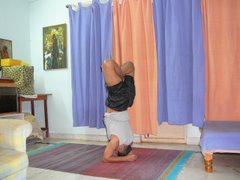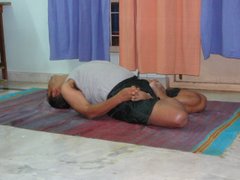Approaching Ardha Matsyendrasana
Ardha (n.) = Half
Matsya (n.) = Fish
Indra (n.) = King
Asana (n.) = Pose
Though transliterating this Asana may be called as King of fish pose, it is not called in such a way. The Asana has been invented by a sage named Matsyendranath, and hence is named after him.
The Asana does exert pressure on the Pancreas which is responsible for secretion of the hormone insulin that regulates the blood sugar.
Hence Matsyendrasana is excellent for fighting diabetes. The above figure illustraes an approach to achieving the Ardha Matsyendrasana, which is a difficult Asana in itelf. In the next few posts, I shall publish the approach and finally reach the Ardha Matsyendrasana.
Tuesday, September 1, 2009
Saturday, January 17, 2009
Kapotasana
Tuesday, August 5, 2008
Ardha Chandrasana
Ardha (adj.) = Half
Chandra (n.) = Moon
Asana (n.) = Pose
Ardha Chandrasana
I am still a novice in this Asana, though the picture was shot in Mar, 2008. Hence I would group it with the "incorrect Asana" tag.
Critique
1) the neck is still not flexible enough to have the chin aligned with the hand. ( I am able to do the Parshva Konasana with the chin is alinged with the arm now)
2) The knee is still not facing forward, it's facing downward.
3) the raised leg is still not in one straight line with the trunk of the body.
Chandra (n.) = Moon
Asana (n.) = Pose
Ardha Chandrasana
I am still a novice in this Asana, though the picture was shot in Mar, 2008. Hence I would group it with the "incorrect Asana" tag.
Critique
1) the neck is still not flexible enough to have the chin aligned with the hand. ( I am able to do the Parshva Konasana with the chin is alinged with the arm now)
2) The knee is still not facing forward, it's facing downward.
3) the raised leg is still not in one straight line with the trunk of the body.
Friday, May 9, 2008
Sarvangasana
Sarvangasana
Sarva (n.) = All
Anga (n.) = Limb
Asana (n.) = Posture
Together these words will mean the posture which exercises all limbs
Self Critique:
Well, thanks to my back pain which is almost gone now, I have not been doing this Asana or any other forward bending Asana for a long time. As I reported sometime earlier, I recently started doing Sarvangasana regularly. But years of non-practice has led to reduce the quality that I seek in everything. First defect in this posture that I see, that the body is not as perpendicular to the ground as I would like it to be. Second, the weight of the body is still borne by wrists and hands here - the force applied by the hands and the waists can be clearly seen. Ideally, the palms should merely rest on the back, they should not exert pressure of the waist to hold the torso straight.
Breathing: Breathe in as you raise the legs to the position, breathe normal as you hold the position, and breathe out as you lower the limbs to the ground.
How to execute the posture:
1) Lie in Savasana
2) perform Ardha halasana
3) Raise your back from the ground with the help of the hands and legs moving from Ardha halasana without resting and in one sweeping motion
Sarva (n.) = All
Anga (n.) = Limb
Asana (n.) = Posture
Together these words will mean the posture which exercises all limbs
Self Critique:
Well, thanks to my back pain which is almost gone now, I have not been doing this Asana or any other forward bending Asana for a long time. As I reported sometime earlier, I recently started doing Sarvangasana regularly. But years of non-practice has led to reduce the quality that I seek in everything. First defect in this posture that I see, that the body is not as perpendicular to the ground as I would like it to be. Second, the weight of the body is still borne by wrists and hands here - the force applied by the hands and the waists can be clearly seen. Ideally, the palms should merely rest on the back, they should not exert pressure of the waist to hold the torso straight.
Breathing: Breathe in as you raise the legs to the position, breathe normal as you hold the position, and breathe out as you lower the limbs to the ground.
How to execute the posture:
1) Lie in Savasana
2) perform Ardha halasana
3) Raise your back from the ground with the help of the hands and legs moving from Ardha halasana without resting and in one sweeping motion
Wednesday, April 23, 2008
Approaching Baddha Padmasana
Approaching Baddha Padmasana
Baddha(adj.) = Bound
Padma (n.) = Lotus
Asana (n.) = Posture
Baddha Padmasana is one of those Asanas that work on the shoulders,chest, back, stomach, genitals, arms, figures, legs, knees. Now, for a beginner this Asana is tough. The puzzles to solve here is how to get those arms sneak around the back and catch hold of the big toes?
I heard such solutions as "your arms/legs are proportionally longer than those of mine". Not quite sir, it's a three piece puzzle.
i) Straighten the back - this is the last piece actually
ii) Increase the reach of your arms - by exercising your back muscles and the ball and socket of your shoulders
iii) Learn to do a tight Padmasana - by moving the foot touch your waist region
In here we are dealing with the second problem.
See? Hold the fingers of your right hand by your left hand and continuously exert a pulling pressure on it. Count twenty breaths. Release your arms lock. Now do the same stuff changing your arms - exert a pulling pressure on the fingers of left hand by your right.
Baddha(adj.) = Bound
Padma (n.) = Lotus
Asana (n.) = Posture
Baddha Padmasana is one of those Asanas that work on the shoulders,chest, back, stomach, genitals, arms, figures, legs, knees. Now, for a beginner this Asana is tough. The puzzles to solve here is how to get those arms sneak around the back and catch hold of the big toes?
I heard such solutions as "your arms/legs are proportionally longer than those of mine". Not quite sir, it's a three piece puzzle.
i) Straighten the back - this is the last piece actually
ii) Increase the reach of your arms - by exercising your back muscles and the ball and socket of your shoulders
iii) Learn to do a tight Padmasana - by moving the foot touch your waist region
In here we are dealing with the second problem.
See? Hold the fingers of your right hand by your left hand and continuously exert a pulling pressure on it. Count twenty breaths. Release your arms lock. Now do the same stuff changing your arms - exert a pulling pressure on the fingers of left hand by your right.
Wednesday, April 16, 2008
Ardha Halasana
Ardha Halasana
Ardha (n.) = Half
Hala (n.) = Plough
Asana (n.) = Posture
Balarama brother of Krishna in Mahabharata (Devaki and Vasudeva's son but who was born in Rohini's womb by somethe miraculous method which sounds like embryo transplantation procedure of today's medical science) was called Haladhara - who holds or carries a plough. Balarama's weapon was a plough.
I talked about this simple, yet so beneficial Asana for treating back pain last year. I practiced this Asana and got wonderful results. Of course, if you have acute back pain, so much so that lifting legs like this is painful. In which case desist doing this Asana. I went through this acute pain too :). With time, and as a result of doing other back pain Asanas as pain is reduced, you can start doing this one.
Ardha (n.) = Half
Hala (n.) = Plough
Asana (n.) = Posture
Balarama brother of Krishna in Mahabharata (Devaki and Vasudeva's son but who was born in Rohini's womb by somethe miraculous method which sounds like embryo transplantation procedure of today's medical science) was called Haladhara - who holds or carries a plough. Balarama's weapon was a plough.
I talked about this simple, yet so beneficial Asana for treating back pain last year. I practiced this Asana and got wonderful results. Of course, if you have acute back pain, so much so that lifting legs like this is painful. In which case desist doing this Asana. I went through this acute pain too :). With time, and as a result of doing other back pain Asanas as pain is reduced, you can start doing this one.
Monday, April 14, 2008
Kanochee Muktahasta Seershasana
Kanochee Muktahasta Seershasana
Kanochee (n.) = Elbow
Seersha (n.) = Head, crown, pinnacle
Asana (.) = Posture
This is the fourth variation of Muktahasta Seershasana of which I spoke sometime Ago. Here, the balance is on the elbows.
I find this Asana quite tough. Balancing on the elbows!!! I would be considering myself successful if I were able to balance on the elbow points, with no part of the forearm supporting me.
Kanochee (n.) = Elbow
Seersha (n.) = Head, crown, pinnacle
Asana (.) = Posture
This is the fourth variation of Muktahasta Seershasana of which I spoke sometime Ago. Here, the balance is on the elbows.
I find this Asana quite tough. Balancing on the elbows!!! I would be considering myself successful if I were able to balance on the elbow points, with no part of the forearm supporting me.
Thursday, April 3, 2008
Bharadwajasana
Bharadwajasana
Alternate spelling: Bharadvajasana
This Asana has been named after Sage Bharadwaja
Who was sage Bharadwaja?
Sage Bharadwaja belongs to the Brahmin clan which was known for its physical activities and practice of the martial arts. He was the father of sage Dronacharya, the teacher of the Pandavas and Kauravas in Mahabharata.
The birth of Drona is quite interesting which has been recounted in the Mahabharata quite elaborately. Since in this case Drona was not born out of a woman, but a clay pot.
Sage Bharadwaja's other son was sage Garga - who was also a vedic scholar as his father. Garga was also a renowned astrologer who gave Krishna his name.
I found this Asana very useful in progressing to Ardha-Matsyedrasana
Breathing: Breath in when twisting the torso to the back. I am still, as usual, still to go a long way grappling this Asana. The twist here should be even more pronounced.
Alternate spelling: Bharadvajasana
This Asana has been named after Sage Bharadwaja
Who was sage Bharadwaja?
Sage Bharadwaja belongs to the Brahmin clan which was known for its physical activities and practice of the martial arts. He was the father of sage Dronacharya, the teacher of the Pandavas and Kauravas in Mahabharata.
The birth of Drona is quite interesting which has been recounted in the Mahabharata quite elaborately. Since in this case Drona was not born out of a woman, but a clay pot.
Sage Bharadwaja's other son was sage Garga - who was also a vedic scholar as his father. Garga was also a renowned astrologer who gave Krishna his name.
I found this Asana very useful in progressing to Ardha-Matsyedrasana
Breathing: Breath in when twisting the torso to the back. I am still, as usual, still to go a long way grappling this Asana. The twist here should be even more pronounced.
Labels:
Ardha Matsyendrasana,
Intermediate Asana,
practice
Subscribe to:
Comments (Atom)

















